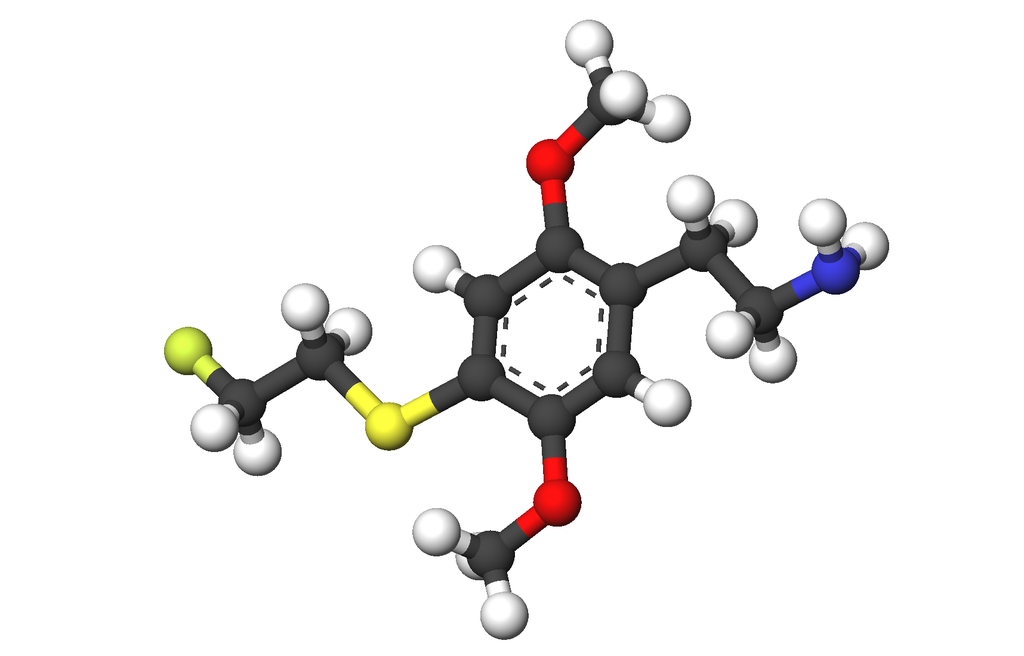Summary
2C-T-21, also known as 4-(2-fluoroethylthio)-2,5-dimethoxyphenethylamine, belongs to the psychedelic phenethylamine family of 2C compounds. This substance is occasionally employed as an entheogen, and its initial synthesis can be attributed to Alexander Shulgin.
| Identifiers | |
|---|---|
| CAS Number | 207740-33-8 [chemspider] |
| 3D model (JSmol) | Interactive image |
| ChEMBL | ChEMBL126582 |
| ChemSpider | 21106231 |
| PubChemCID | 44349972 |
| UNII | 720O3Q04GA |
| CompTox Dashboard(EPA) | DTXSID00174851 |

Effects
2C-T-21 is typically ingested orally, and its effects tend to endure for a duration of 7 to 10 hours. Myron Stolaroff delved into the potential psychotherapeutic uses of this compound.
Pharmacology
The precise mechanism underlying the hallucinogenic and entheogenic effects of 2C-T-21 has not been definitively determined. However, it is likely associated with its action as a 5-HT2A serotonin receptor agonist in the brain, which is a common mechanism of action shared with other known hallucinogenic tryptamines and phenethylamines.

Dangers
On March 9, 2004, a 22-year-old quadriplegic individual named James Edwards Downs, residing in St. Francisville, Louisiana, ingested an unknown quantity of 2C-T-21 by direct contact with a vial of the powder he had obtained from an online source. This resulted in a severe adverse reaction, with a body temperature reaching 108 °F (42 °C), a tonic-clonic seizure, and subsequent entry into a coma. Tragically, James Edwards Downs passed away on March 13, 2004, at Lane Memorial Hospital in Zachary, LA.
This incident became a part of a comprehensive two-year investigation conducted by the DEA, referred to as Operation Web Tryp, initiated in 2002. As a consequence of their investigation, on July 22, 2004, the proprietors of American Chemical Supply were apprehended on federal charges related to the distribution of controlled substance analogues and their involvement in the unfortunate demise of James Edwards Downs. However, limited information is available regarding the toxicological aspects of 2C-T-21 beyond this specific case.
Legality
2C-T-21 remains unscheduled and uncontrolled in the United States; however, it’s important to note that its possession and distribution could likely lead to prosecution under the Federal Analog Act. This is primarily due to the structural resemblances between 2C-T-21 and 2C-T-7, as well as the documented instances of fatal outcomes associated with its use. Following Operation Web Tryp in July 2004, at least one distributor faced legal charges in connection with the unfortunate overdose death of James Downs, which was linked to 2C-T-21.
FAQ
- What is 2C-T-21? 2C-T-21 is a psychedelic phenethylamine belonging to the 2C family. It is sometimes used as an entheogen and was first synthesized by Alexander Shulgin.
- How is 2C-T-21 typically consumed? It is usually taken orally, and its effects can last approximately 7 to 10 hours.
- Are there any potential therapeutic applications for 2C-T-21? Myron Stolaroff explored the potential psychotherapeutic applications of this chemical.
- What is the mechanism behind the hallucinogenic effects of 2C-T-21? While the exact mechanism isn’t established, it is suggested that these effects may result from its action as a 5-HT2A serotonin receptor agonist in the brain, a common mechanism shared by many hallucinogenic substances.
- Are there any known incidents of harm associated with 2C-T-21? Yes, a tragic incident occurred where a quadriplegic man consumed 2C-T-21, leading to severe health complications and his subsequent passing. This incident prompted an investigation known as Operation Web Tryp.
- Is 2C-T-21 regulated in the United States? 2C-T-21 is currently unscheduled and uncontrolled in the United States. However, due to its structural similarities to controlled substances like 2C-T-7 and the potential for adverse effects, possession and distribution could result in legal consequences under the Federal Analog Act.
- Where can I find more information about 2C-T-21? You can refer to scientific literature, research studies, and government regulations for more information on this substance.
References
- Alexander Shulgin introduced 2C-T-21 in his book “PiHKAL” as a member of the 2C family of psychedelic phenethylamines.
- On July 22, 2004, the DEA issued a news release regarding 2C-T-21, highlighting its inclusion in Operation Web Tryp, an investigation launched in 2002.
- The Regulations Amending the Food and Drug Regulations (Part J — 2C-phenethylamines) provide legal insights into the regulation of substances like 2C-T-21, aiming to control their distribution and use.